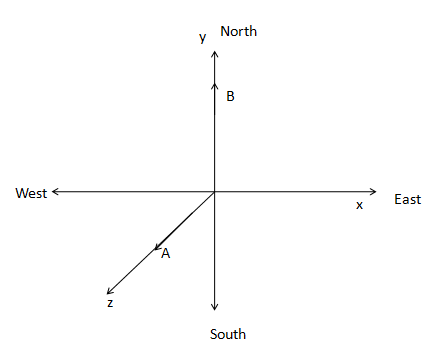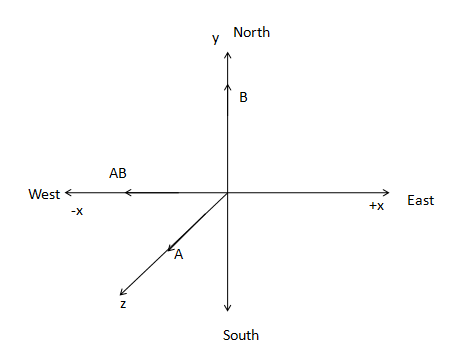
A vector A points vertically upward and B points towards north. The vector product \[\overrightarrow A \times \overrightarrow B\] is:
$(A)$ Null vector
$(B)$ Along west
$(C)$ Along east
$(D)$ Vertically downward
Answer
216.6k+ views
Hint: Draw a clear picture of the direction of the vectors along three axes. Note that, vertically upward means the direction along the normal to the plane of the paper in which we are drawing.
After getting the axis of the vectors represent the vectors with unit vectors related to those axes.
Here in the problem cross product is needed, so do the cross product of the vectors find the direction of the product based on the sign.
Formula used:
If $\widehat i,\widehat j,\widehat k$ are the unit vectors along $x,y,z$ axis respectively, then one of the relations between the unit vectors related to cross multiplications is :
$\widehat j \times \widehat k = \widehat i$
$ \Rightarrow \widehat k \times \widehat j = - \widehat i$
Complete step by step answer:
A vector $\overrightarrow A $ is along vertically upward and another vector $\overrightarrow B $ is along the north direction. If this is drawn in a plane of a paper it looks like:

$\overrightarrow A $is along the $z$ axis that is along the normal direction to the plane of the paper. $\overrightarrow B $ is along the $y$ axis that is along the north direction to the plane.
If $\widehat i,\widehat j,\widehat k$ are the unit vectors along the positive $x,y,z$ axis respectively, then
\[\overrightarrow A = A\widehat k\]
And, \[\overrightarrow B = B\widehat j\]
We know, one of the relations between the unit vectors related to cross multiplications is :
$\widehat j \times \widehat k = \widehat i$
$ \Rightarrow \widehat k \times \widehat j = - \widehat i$
Hence, $\overrightarrow A \times \overrightarrow B = A\widehat k \times B\widehat j = AB( - \widehat i)$
$\therefore \overrightarrow A \times \overrightarrow B = - AB\widehat i$
Since the unit vector is $\widehat i$ with a negative sign, the resultant vector will be along the negative $x$ axis. From the figure it can be seen that the negative $x$ axis is directed towards the west direction.

Hence the correct option is (B).
Note: $\widehat i,\widehat j,\widehat k$ are the unit vectors along the positive $x,y,z$ axis respectively. Each of them has a value $1$ .
Since $\overrightarrow A \times \overrightarrow A = 0$ ;
Hence, $\widehat i \times \widehat i = \widehat j \times \widehat j = \widehat k \times \widehat k = 0$ .
Again, the value of $\widehat i \times \widehat j = \left| {\widehat i \times \widehat j} \right| = \left( 1 \right).\left( 1 \right).\sin {90^ \circ } = 1$
The rule of right hand cork-screw, the direction of $\widehat i \times \widehat j$ is along the $z$ axis. Since $\widehat k$ is the unit vector along the $z$ axis, so $\widehat i \times \widehat j = \widehat k$
According to this rule, $\widehat i \times \widehat j = \widehat k$, $\widehat j \times \widehat k = \widehat i$ and, \[\widehat k \times \widehat i = \widehat j\]
Since, $\overrightarrow A \times \overrightarrow B = - \overrightarrow B \times \overrightarrow A $
Hence, $\widehat j \times \widehat i = - \widehat k$, $\widehat k \times \widehat j = - \widehat i$ and, \[\widehat i \times \widehat k = - \widehat j\]
After getting the axis of the vectors represent the vectors with unit vectors related to those axes.
Here in the problem cross product is needed, so do the cross product of the vectors find the direction of the product based on the sign.
Formula used:
If $\widehat i,\widehat j,\widehat k$ are the unit vectors along $x,y,z$ axis respectively, then one of the relations between the unit vectors related to cross multiplications is :
$\widehat j \times \widehat k = \widehat i$
$ \Rightarrow \widehat k \times \widehat j = - \widehat i$
Complete step by step answer:
A vector $\overrightarrow A $ is along vertically upward and another vector $\overrightarrow B $ is along the north direction. If this is drawn in a plane of a paper it looks like:

$\overrightarrow A $is along the $z$ axis that is along the normal direction to the plane of the paper. $\overrightarrow B $ is along the $y$ axis that is along the north direction to the plane.
If $\widehat i,\widehat j,\widehat k$ are the unit vectors along the positive $x,y,z$ axis respectively, then
\[\overrightarrow A = A\widehat k\]
And, \[\overrightarrow B = B\widehat j\]
We know, one of the relations between the unit vectors related to cross multiplications is :
$\widehat j \times \widehat k = \widehat i$
$ \Rightarrow \widehat k \times \widehat j = - \widehat i$
Hence, $\overrightarrow A \times \overrightarrow B = A\widehat k \times B\widehat j = AB( - \widehat i)$
$\therefore \overrightarrow A \times \overrightarrow B = - AB\widehat i$
Since the unit vector is $\widehat i$ with a negative sign, the resultant vector will be along the negative $x$ axis. From the figure it can be seen that the negative $x$ axis is directed towards the west direction.

Hence the correct option is (B).
Note: $\widehat i,\widehat j,\widehat k$ are the unit vectors along the positive $x,y,z$ axis respectively. Each of them has a value $1$ .
Since $\overrightarrow A \times \overrightarrow A = 0$ ;
Hence, $\widehat i \times \widehat i = \widehat j \times \widehat j = \widehat k \times \widehat k = 0$ .
Again, the value of $\widehat i \times \widehat j = \left| {\widehat i \times \widehat j} \right| = \left( 1 \right).\left( 1 \right).\sin {90^ \circ } = 1$
The rule of right hand cork-screw, the direction of $\widehat i \times \widehat j$ is along the $z$ axis. Since $\widehat k$ is the unit vector along the $z$ axis, so $\widehat i \times \widehat j = \widehat k$
According to this rule, $\widehat i \times \widehat j = \widehat k$, $\widehat j \times \widehat k = \widehat i$ and, \[\widehat k \times \widehat i = \widehat j\]
Since, $\overrightarrow A \times \overrightarrow B = - \overrightarrow B \times \overrightarrow A $
Hence, $\widehat j \times \widehat i = - \widehat k$, $\widehat k \times \widehat j = - \widehat i$ and, \[\widehat i \times \widehat k = - \widehat j\]
Recently Updated Pages
JEE Atomic Structure and Chemical Bonding important Concepts and Tips

JEE Amino Acids and Peptides Important Concepts and Tips for Exam Preparation

Electricity and Magnetism Explained: Key Concepts & Applications

Chemical Properties of Hydrogen - Important Concepts for JEE Exam Preparation

JEE Energetics Important Concepts and Tips for Exam Preparation

JEE Isolation, Preparation and Properties of Non-metals Important Concepts and Tips for Exam Preparation

Trending doubts
JEE Main 2026: Application Form Open, Exam Dates, Syllabus, Eligibility & Question Papers

Derivation of Equation of Trajectory Explained for Students

Hybridisation in Chemistry – Concept, Types & Applications

Understanding the Angle of Deviation in a Prism

Understanding Collisions: Types and Examples for Students

How to Convert a Galvanometer into an Ammeter or Voltmeter

Other Pages
JEE Advanced Marks vs Ranks 2025: Understanding Category-wise Qualifying Marks and Previous Year Cut-offs

Units And Measurements Class 11 Physics Chapter 1 CBSE Notes - 2025-26

NCERT Solutions For Class 11 Physics Chapter 8 Mechanical Properties Of Solids

Motion in a Straight Line Class 11 Physics Chapter 2 CBSE Notes - 2025-26

NCERT Solutions for Class 11 Physics Chapter 7 Gravitation 2025-26

Understanding Atomic Structure for Beginners




